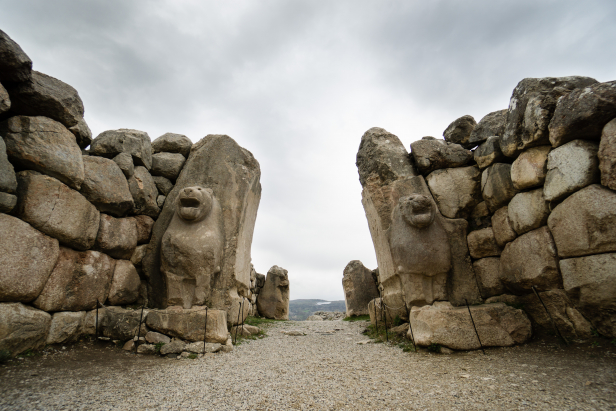Hattusha: The Hittite Capital
/ By Josh
A UNESCO World Heritage site since 1986, the vast ruins of Hattusha are the number one reason for visiting Çorum. With rebuilt walls, tunnels, ramparts, and ancient gateways, the Hittite capital is certainly the most impressive Hittite site found to date.
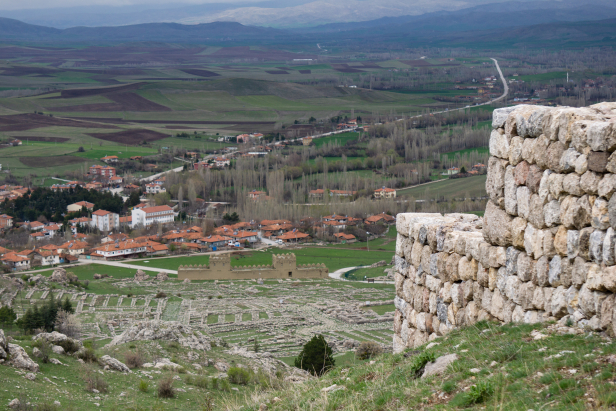
The city of Hattusha, next to the modern village of Boğazkale, was the glorious administrative centre of an empire that spanned from Western Turkey to Lebanon, Syria, and Iraq. It’s people sacked Babylon, defeated the Egyptians, and was ranked among the three great powers of the bronze age.

Hattusha was the Hittite capital for around 500 years, from the 17th century BC till the demise of the empire around 1250 BC. In that time the city amassed great wealth, built massive walls, temples, storehouses, palaces, and libraries. Unlike the other great empires of the time, the Hittites appear to have been much more utilitarian, and didn’t produce art nearly as fine.
Subscribe to The Art of Wayfaring
As Hittite architecture was dominantly brickwork set within wooden frames, nearly everything has been lost to fire, rain, and time, leaving only foundations, cobbled streets, and gateways, all of which were made of stone.
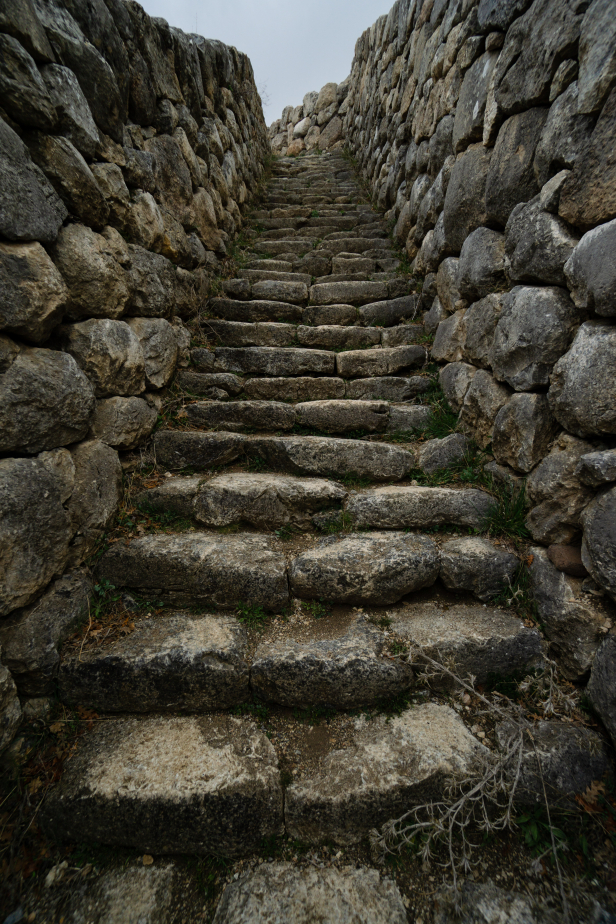
Today the attraction consists of three parts: the ruined city of Hattusha, the Hittite holy site of Yazılıkaya, and the archaeology museum displaying many of the artifacts discovered in the area. While we’ve written a brief guide to these places, we’d highly recommend A Day in the Hittite Capital, an excellent guide written by Jürgen Seeher for anyone wanting a deeper understanding of the Hittites and this magnificent city. (Click here for more on our favorite guidebooks)
Why Visit?
The City of Hattusha
Hattuşa/Hattuşaş
Cost: 10tl
Müze Card Accepted
Passing through the ancient city in a great loop is a modern road built to get visitors from one sight to the next. Using this road you’ll be able to access all of the main attractions though there are a number of parts that will require a bit of extra hiking to get to.
Below is a list of some of the highlights listed in the order that you’ll see them as you follow the roadway.
THE REBUILT WALL
At the entrance to the museum grounds a hulking section of wall has been rebuilt in what is believed to be the original style using ancient methods and technologies. This portion of wall is 65 metres long, 8 metres high and has a pair of towers measuring 13 metres in height. To build this portion of the wall, 64,000 mud bricks were made, weighing 34 kgs each! You can see the stone foundations beneath the plastered brickwork as they must have appeared thousands of years ago.
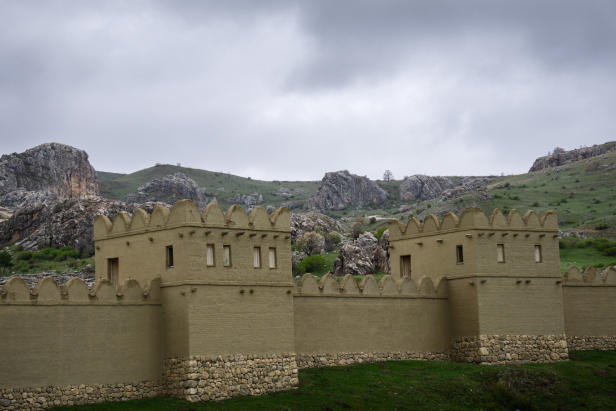
While the wall was built to give a sense of scale and appearance to the ancient site, it was also built as an experiment, allowing archaeologists to gain a better understanding of ancient building, and maintenance methods that the Hittites must have used.
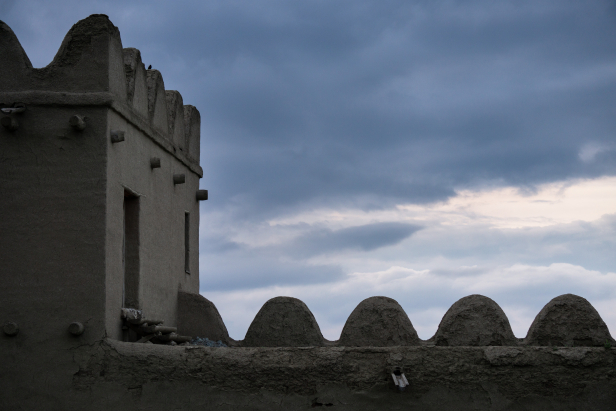 Subscribe to The Art of Wayfaring
Subscribe to The Art of Wayfaring
THE GREAT TEMPLE AND GREEN STONE
Just to the right of the roadway, a couple hundred metres from the entrance, is the great temple site of the lower city. Built at an unknown date atop an older layer of settlement, the Great Temple was built with massive stone blocks and paved with huge flat, tightly joined stones, some of the largest that you’ll see used (or at least remaining) in the city. The temple site is 14500 metres square and around two hundred store rooms of oil, food, and other things for religious ceremonies. Some of the great earthen jars found in the Great Temple have a capacity of 2000 litres!
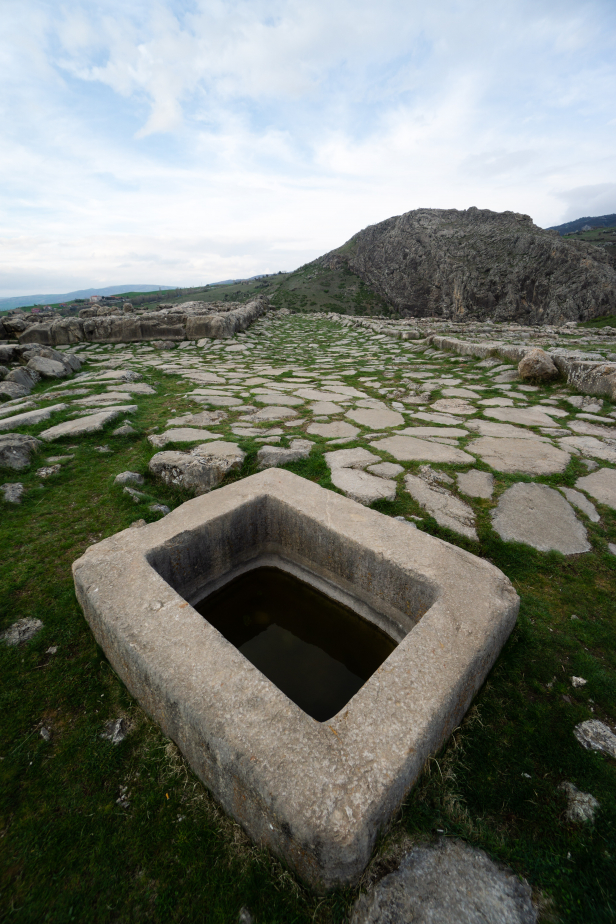
One of the most important finds here is the vast collection of thousands of clay tablets that brought to life many aspects of Hittite religion, politics, and life in general.
By the parking lot is the remains of a massive stone basin carved with lions at the corners. Sadly it was broken apart by Roman or Byzantine masons looking to use the high quality stone.

One of the most well-known sights in the Great Temple is the highly polished green stone, the exact purpose of which is still a mystery. Theories range from it being a meteorite, to it having been brought from Egypt though neither of these are likely as this type of green stone is actually found in the area.
THE LION GATE
The first of the decorated gates that you’ll come across as you follow the road upwards is the Lion Gate. This gateway was built with two large lion statues set on either side of the portal, and as symbols of strength they are believed to have been set to guard the entrance to the city.
The larger lion on the left was already damaged when the site was first excavated and only recently restored, if somewhat awkwardly. The lions’ eyes would have been set with white limestone, and their teeth bared in a snarl.
YERKAPI AND THE SPHINX GATE
Yerkapı, meaning ‘earth or ground gate’ gets its name from the 70 metre long tunnel that runs beneath a massive, man-made hill, at the highest point in the city. The tunnel itself was built before ancient engineers had developed true arches and so to find such a large and well preserved tunnel of this type is quite special. The tunnel exits at the base of the rampart in a small, though obvious, building making it rather useless as a sally port and so likely to have been built in times of peace.
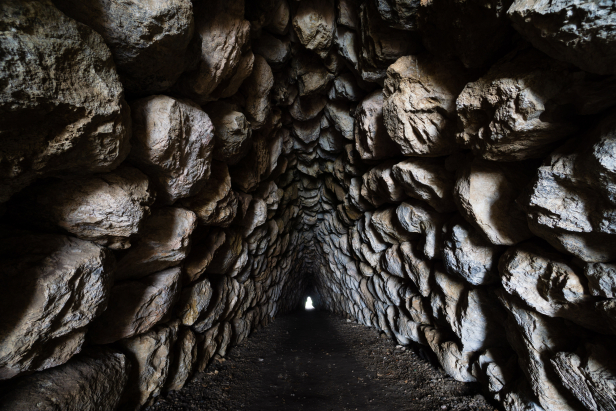
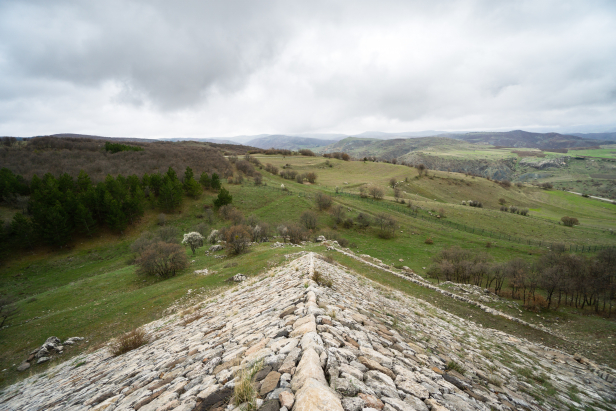

The rampart itself is shaped like a section of pyramid, 250 metres wide and 30 metres tall. On either side are staircases running up to the top where a wall stood. A second wall was added later to increase the strength of the fortification though it also blocked the stairs on the one side.
These great fortifications, though impressive, were most likely built as a monument rather than purely for defence. An attacking force could simply attack a little distance away on either side and totally ignore the entire Yerkapı construction.

At the top of the rampart is the Sphinx Gate: an unusual gate that was built with four sphinxes guarding the two sets of doors that were set in a tower. These particular sphinxes, with there hoods, show something of the influence of the Egyptians on the Hittite sculptors. From here, if you look back into the city, you’ll see a small sloping hill just below the road with the foundations of around thirty temples in the grass.
THE KING’S GATE
Beyond the rampart of Yerkapı you’ll come across a gate known as the king’s gate, with a figure carved in high-relief on the left side. The statue that is there today is a replica as the original has been taken to the Museum of Anatolian Civilizations in Ankara. When the statue was fist discovered it was believed that the statue depicted a king, though some hypothesized that it was actually a woman, perhaps an Amazon. While the name ‘King’s Gate’ remained, it’s now believed that the figure is actually a god because of the horns on the warrior’s helmet, a sign of divinity. Also, hair carved around the nipple meant it couldn’t be an Amazonian warrior.
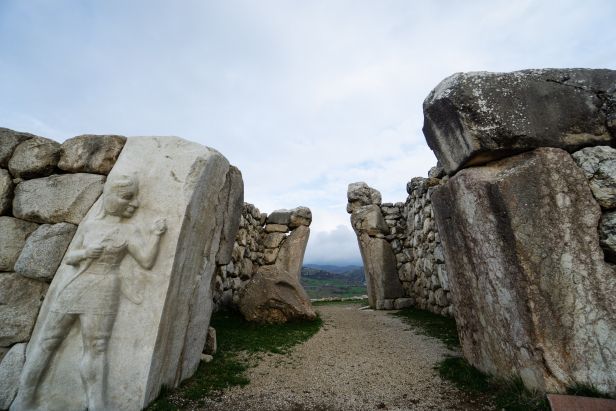
CHAMBERS 1&2
Continuing down the hill from the King’s Gate you’ll see an oddly shaped chamber on the right side of the road (if you’re driving go just a little further and stop at the parking space by Nişantaşı). This chamber is the first of a pair of chambers built in this area. Chamber 1 was built into the outside of a water reservoir wall, the outline of which you can still see today.
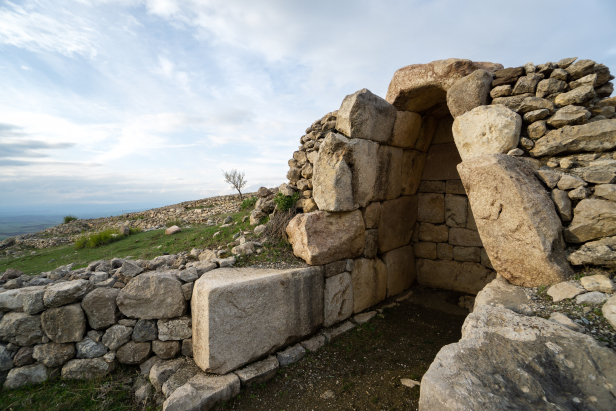

Chamber 2, also known as the hieroglyph chamber, is just around the corner from Chamber 1 and, as its name suggests, is full of hieroglyphs. When archaeologists first discovered the chamber it was in ruins. The stones were scattered and had to be reassembled. The construction, like Chamber 1 is another example of early arches, much less strong and prone to collapse.
On the left side of the arch is a figure identified as King Shapinuwa II, and on the right side of the chamber is a long commemorative inscription in hieroglyph concerning his deeds. At the far end of the chamber is the figure of the sun god. It is thought that the chamber may have been a symbolic entryway into the underworld.
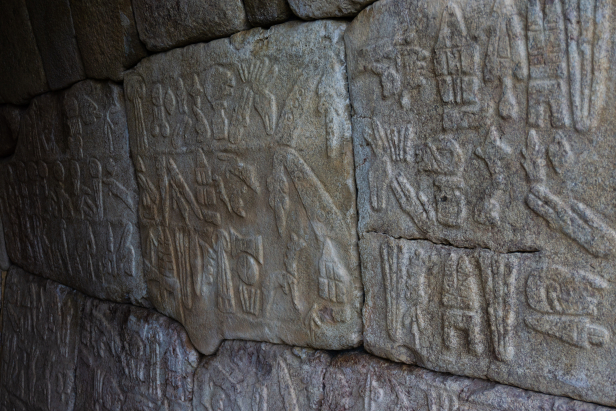
NİŞANTAŞI
At Nişantaşı is the ruins of yet another chamber though it has not been reconstructed and its exact nature is not fully known. Nişantaşı, meaning ‘inscribed rock’ gets its name from a massive inscription written in Hittite Cunieophorm. The inscription has been badly weathered making it impossible to fully translate. From what can be made out the inscription seems to be primarily concerned with the deeds of King Shuppiluliuma II.
THE GREAT CASTLE
The Great Castle, also referred to as Büyükkale, is a high and easily defendable acropolis within the city. Due to its easily defensible position it was the site of the earliest settlements at Hattusha dating back to around 3000 BC, long before the Hittites founded their imperial city. After the collapse of the Hittites around 1250 BC it was here that settlements continued, rebuilt by the Phrygians and regularly used till the Byzantine era.
During the time of the Hittites however, this site became a royal residence, cut off from the rest of the city with its high cliffs and strong walls. The royal family and the king’s small army of personal guards lived in this fortified complex.
Residences, meeting halls, pools, and libraries were all discovered within the Great Castle. Perhaps most important of all is the information that was learned from the surviving clay tablets from the library revealing details about Hittite religious practices, prophetic predictions, folklore, and law.
AND…
Beyond the sights listed here there are many other parts of the city that you may want to stop and explore, some, right along the road, and others a short hike through the hills and ravines. If you’re at all interested in having a better understanding of Hattusha, it’s history, and want to know more about everything that you’ll see here, we’d highly recommend picking up A Day in the Hittite Capital, by Jürgen Seeher.
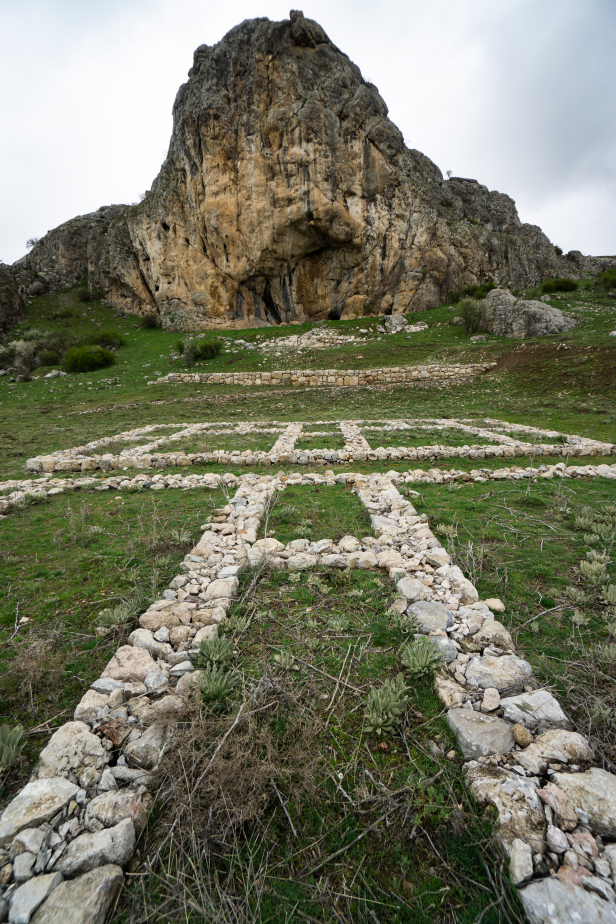
Yazılıkaya
Cost: Free

A short drive from the city of Hattusha is the remains of a Hittite holy site dating back to the 15th century BC. The site is thought to be connected to the Hittite New Year celebration where all the Hittite deities were welcomed in anticipation of the coming spring.
The site consisted of three parts; two natural chambers and a set of small buildings cutting off the chambers from the outside world.
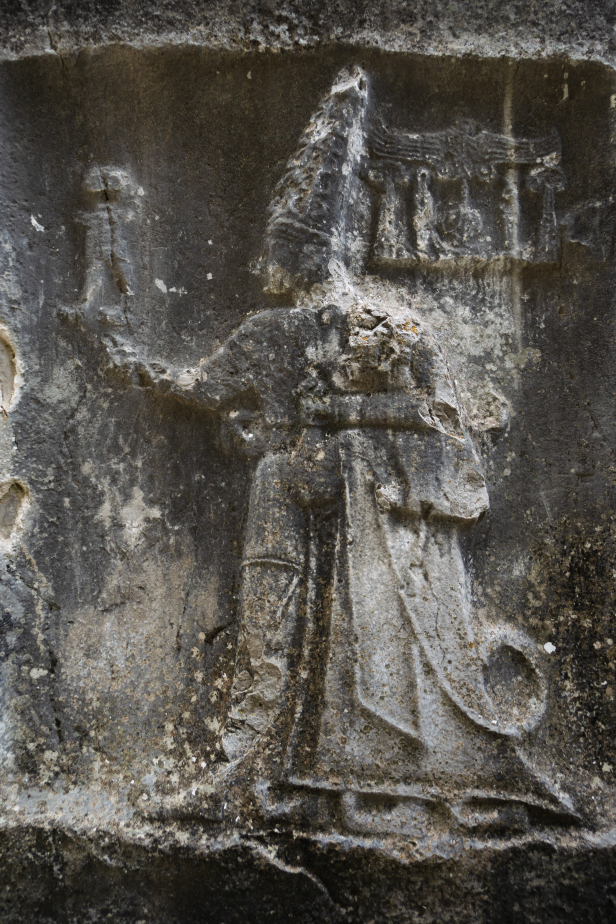
While nothing remains of the outer buildings, it’s the carvings of the chambers that have captured the imagination of visitors since French Archaeologist Charles Texier first visited in the 1830’s.
Both chambers are actually naturally formed gullies, with the surrounding rocks reaching up to 10 metres high. The sheer faces of the rock have been carved with long processions of Hittite deities and rulers totalling sixty six individual figures.
Boğazkale Museum
Boğazkale Müzesi
Cost: 6tl
Müze Card Accepted
Within the modern town of Boğazkale there is a small museum displaying a fine collection of artifacts from the digs at Hattusha. While the museum is primarily focused on the Hittite period, it does an excellent job at connecting the city of Hattusha to the older civilizations and what came after the Hittites disappeared.
Models of the reconstructed city help give a sense of the sheer size and style of the place in a way that is hard to do just by wandering the ruins.
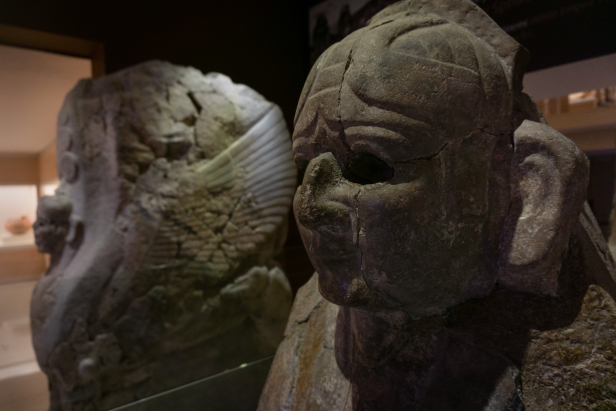
Chief among the items on display are a pair of sphinxes from the Sphinx Gate, recently returned from the Berlin Museum. Beyond these there is scale armor, weapons, clay tablets and much more. Other displays serve to introduce the culture of the Hittites through their strange writing systems, myths, and hundreds of gods.
How To Get There
Public Transport
The fact that Boğazkale is a far from all major city centres does hurt the local tourism sector. At 85kms from the city of Çorum taking public transit will require some patience. From Çorum you’ll need to take a bus from the main bus station on the edge of town and go to the town of Sungurlu. From there you can catch a dolmuş to the town of Boğazkale where Hattusha is. Dolmuşes don’t tend to run on a schedule, rather they go when they fill up (which is what their name means) so planning for this may be a bit tough.
Car
From Çorum
From Çorum the total distance is about 85 kms. Head south-west out of the city on the D785 highway. About 60 kms down this road you’ll see signs directing you to turn left to Boğazkale and Hattusha. From this point you’ll stay on the D190 highway (which will become the Boğazkale road partway down) until you reach Boğazkale.
For more about car rental and driving in Turkey make sure to read our full drivers guide.
From Ankara
From Ankara the total distance is about 200 kilometres. Head east out of the city on the D200 which becomes the E88 at the city of Kırıkkale. Carry on 50 kms then take the turn-off towards Çorum. From the junction head north-east on the D190 for 55 kilometres where you’ll see signs directing you to turn right to Boğazkale and Hattusha. From there simply follow this road and the signs till you reach Boğazkale.
Where To Stay
There is a fairly good selection of hotels in the town of Boğazkale, though, being exclusively aimed at tourists, prices are a little higher than you would find in Çorum city centre. Prices still aren’t bad and the quality of these hotels tends to be rather good
Be aware that, as tourism drops off quite sharply in this area during the winter some of the hotels in Boğazkale will be closed for the season so make sure you don’t wait till late in the evening to get a hotel and make your dinner plans.
Outside of Boğazkale, your next best option is in the City of Çorum (80 kms away) where there are plenty of options for great value.
Other Tips
If you’re planning on visiting Hattusha or are really interested in Hittite history then you may want to visit Alacahöyük and Şapinuwa Hittite archaeological sites.
Have any tips or info to add? Spot any mistakes? We’d love to hear about it.

